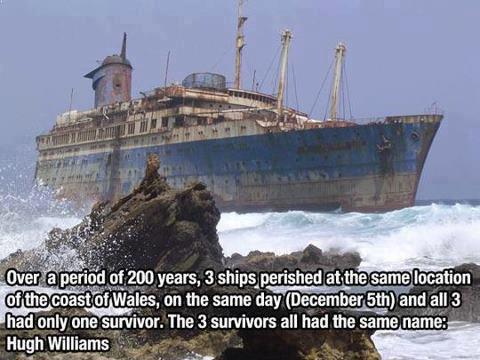HMS Friday: The Legend of Hugh Williams

On December 5, 1664, a ship sunk in the Menai Strait,
a stretch of water with tremendous tidal swings off the coast of Wales. All 81 passengers died, except one. His name was Hugh Williams.
On December 5, 1785, another ship sunk in the Menai Strait, with again everyone aboard dying except for one man…named Hugh Williams.
And then again, on December 5, 1820, yet another ship sunk in the Menai Strait. Only one man survived, and he was named Hugh Williams.
This is an awesome legend, and the scope of the coincidence is staggering. Another source actually references two other British shipwrecks with the lone survivors bearing the name Hugh Williams, except they weren’t on December 5. In one of those wrecks, there were actually two survivors, an uncle and nephew, and both were named Hugh Williams. And so despite having two survivors, you could still technically say of the wreck “the only man to survive was named Hugh Williams.”
While the story can be found all over the web, explanations for it are nowhere to be found. Only one site includes source reference to the Hugh Williams legend, but those are little more than just re-tellings of the legend in books about Northern Wales.
I think above all else, this legend is a wonderful case study in the art of storytelling. The story is sensational, brief, and gets right to the point of the bizarre coincidence of the many men named Hugh Williams.
So I want to play Debbie Downer for a bit. This story under-examines many critical details that make it far less sensational, so let’s look at those.
First off, the coast of Wales is a really dangerous place for ships. It is one of the most weather-exposed areas of the United Kingdom, an island kingdom heavily dependent upon sea travel. The reason there are so many British shipwreck stories is because there were so many British shipwrecks, period. And a whole heap of them along the northern coast of Wales. More shipping leads to more shipwrecks, just pure and simple.
I unfortunately can’t get a higher resolution image of this map of shipwrecks along the North Wales coast, but even without much detail, you can clearly see that there are a lot of shipwrecks from over the years.
The legend makes it sound like there have only ever been 3 shipwrecks in the Menai Strait. The real number is probably closer to 300.
So, to update our legend, we should add the fact that we are addressing three shipwrecks out of hundreds that have occurred in this area.
Now, to the coincidence of the date. I can’t find a list to confirm this, but my suspicion is that most of shipwrecks in the Menai Strait occur during the winter. If you look at the typical seasonal climate of Wales, early winter is the most notorious time of year for wet, windy, and stormy weather. The ocean is also at its coldest. December 5 falls during the prime season for treacherous weather, with the coldness of the water increasing the likelihood of fatalities involved in any shipwreck.
To update our legend further, we should add that the shipwrecks occurred on December 5, during the most dangerous time of the year for shipping in an already dangerous area.
And finally, the name itself. It should be little surprise that the surname “Williams” is very prevalent in Wales. And “Hugh,” (actually “Hew” if we want to stick to the original Welsh) is a very popular first name, listed at every online resource I can find about Welsh names.
So the fact that these various survivors were all named Hugh Williams is not that strange. Not as strange as if they were all named, I don’t know, Ziggy Stardust.
What we have are three shipwrecks in the Menai Strait, a veritable graveyard of shipwrecks, occurring during a dangerous part of the year, which coincidentally happens to be the same day, and each of those shipwrecks left a solitary survivor with the same, popular name.
That’s a much less fun way to tell the story, isn’t it?
I beleaguer these details because I really, really want this story to be true. But I also want unicorns to be true. Wanting something to be true doesn’t make it so; it also needs to be believable. When you understand the prevalence of shipwrecks on the Welsh coastline, especially during winter, the legend becomes more believable. The same for when you think about how common the name Hugh Williams is.
I needed it to be less sensational, because then it’s easier for me to believe. When I tell the story to people, I’ll obviously stick to the sensational version. But I’ll be able to tell it knowing that there’s a good chance that it’s true
.
.




No comments:
Post a Comment